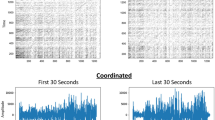Abstract
Coordinated action between music orchestra performance, driven by a conductor, is a remarkable instance of interaction/communication. However, a rigorous testing of inter-individual coordination in an ecological scenario poses a series of technical problems. Here we recorded violinists’ and conductor’s movements kinematics in an ecological interactive scenario. We searched for directed influences between conductor and musicians and among musicians by using the Granger Causality method. Our results quantitatively show the dynamic pattern of communication among conductors and musicians. Interestingly, we found evidence that the aesthetic appreciation of music orchestras’ performance is based on the concurrent increase of conductor-to-musicians causal influence and reduction of musician-to-musician information flow.
Access this chapter
Tax calculation will be finalised at checkout
Purchases are for personal use only
Similar content being viewed by others
References
Rizzolatti, G., Craighero, L.: The mirror-neuron system. Annu. Rev. Neurosci. 27, 169–192 (2004)
Couzin, I.D., Krause, J., Franks, N.R., Levin, S.A.: Effective leadership and decision-making in animal groups on the move. Nature 433(7025), 513–516 (2005)
Frith, C.D.: Social cognition. Philos Trans. R Soc. Lond B Biol. Sci. 363(1499), 2033–2039 (2008)
Grafton, S.T., Hamilton, A.F.: Evidence for a distributed hierarchy of action representation in the brain. Hum. Mov. Sci. 26(4), 590–616 (2007)
Newman-Norlund, R.D., van Schie, H.T., van Zuijlen, A.M., Bekkering, H.: The mirror neuron system is more active during complementary compared with imitative action. Nat. Neurosci. 10(7), 817–818 (2007)
Rands, S.A., Cowlishaw, G., Pettifor, R.A., Rowcliffe, J.M., Johnstone, R.A.: Spontaneous emergence of leaders and followers in foraging pairs. Nature 423(6938), 432–434 (2003)
Sebanz, N., Bekkering, H., Knoblich, G.: Joint action: bodies and minds moving together. Trends. Cogn. Sci. 10(2), 70–76 (2006)
Geweke, J.: Measurement of linear dependence and feedback between multiple time series. J. Am. Stat. Ass. 77, 304–313 (1982)
Granger, C.W.J.: Investigating causal relations by econometric models and cross-spectral methods. Econometrica 37, 424–438 (1969)
Münte, T.F., Altenmüller, E., Jäncke, L.: The musician’s brain as a model of neuroplasticity. Nat. Rev. Neurosci. 3(6), 473–478 (2002)
Author information
Authors and Affiliations
Editor information
Editors and Affiliations
Rights and permissions
Copyright information
© 2012 ICST Institute for Computer Science, Social Informatics and Telecommunications Engineering
About this paper
Cite this paper
D’ausilio, A. et al. (2012). Communication in Orchestra Playing as Measured with Granger Causality. In: Camurri, A., Costa, C. (eds) Intelligent Technologies for Interactive Entertainment. INTETAIN 2011. Lecture Notes of the Institute for Computer Sciences, Social Informatics and Telecommunications Engineering, vol 78. Springer, Berlin, Heidelberg. https://doi.org/10.1007/978-3-642-30214-5_37
Download citation
DOI: https://doi.org/10.1007/978-3-642-30214-5_37
Publisher Name: Springer, Berlin, Heidelberg
Print ISBN: 978-3-642-30213-8
Online ISBN: 978-3-642-30214-5
eBook Packages: Computer ScienceComputer Science (R0)




